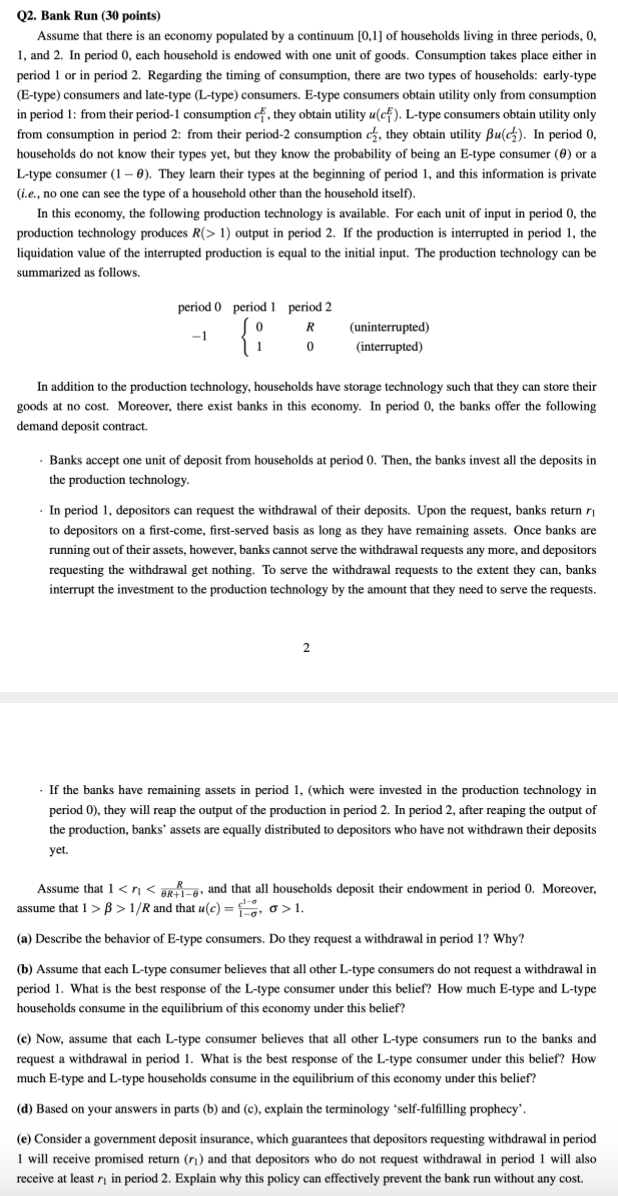Answered step by step
Verified Expert Solution
Question
1 Approved Answer
Q2. Bank Run (30 points) Assume that there is an economy populated by a continuum [0,1] of households living in three periods, 0, 1,

Q2. Bank Run (30 points) Assume that there is an economy populated by a continuum [0,1] of households living in three periods, 0, 1, and 2. In period 0, each household is endowed with one unit of goods. Consumption takes place either in period 1 or in period 2. Regarding the timing of consumption, there are two types of households: early-type (E-type) consumers and late-type (L-type) consumers. E-type consumers obtain utility only from consumption in period 1: from their period-1 consumption of, they obtain utility u(cf). L-type consumers obtain utility only from consumption in period 2: from their period-2 consumption c, they obtain utility Bu(c). In period 0, households do not know their types yet, but they know the probability of being an E-type consumer (0) or a L-type consumer (1-0). They learn their types at the beginning of period 1, and this information is private (i.e., no one can see the type of a household other than the household itself). In this economy, the following production technology is available. For each unit of input in period 0, the production technology produces R(> 1) output in period 2. If the production is interrupted in period 1, the liquidation value of the interrupted production is equal to the initial input. The production technology can be summarized as follows. period 0 period 1 period 2 R -1 0 1 (uninterrupted) (interrupted) In addition to the production technology, households have storage technology such that they can store their goods at no cost. Moreover, there exist banks in this economy. In period 0, the banks offer the following demand deposit contract. Banks accept one unit of deposit from households at period 0. Then, the banks invest all the deposits in the production technology. In period 1, depositors can request the withdrawal of their deposits. Upon the request, banks return to depositors on a first-come, first-served basis as long as they have remaining assets. Once banks are running out of their assets, however, banks cannot serve the withdrawal requests any more, and depositors requesting the withdrawal get nothing. To serve the withdrawal requests to the extent they can, banks interrupt the investment to the production technology by the amount that they need to serve the requests. 2 If the banks have remaining assets in period 1, (which were invested in the production technology in period 0), they will reap the output of the production in period 2. In period 2, after reaping the output of the production, banks' assets are equally distributed to depositors who have not withdrawn their deposits yet. Assume that 1 < < @R+1-e, and that all households deposit their endowment in period 0. Moreover, assume that 1 > > 1/R and that u(c) = 1,0>1. (a) Describe the behavior of E-type consumers. Do they request a withdrawal in period 1? Why? (b) Assume that each L-type consumer believes that all other L-type consumers do not request a withdrawal in period 1. What is the best response of the L-type consumer under this belief? How much E-type and L-type households consume in the equilibrium of this economy under this belief? (c) Now, assume that each L-type consumer believes that all other L-type consumers run to the banks and request a withdrawal in period 1. What is the best response of the L-type consumer under this belief? How much E-type and L-type households consume in the equilibrium of this economy under this belief? (d) Based on your answers in parts (b) and (c), explain the terminology 'self-fulfilling prophecy'. (e) Consider a government deposit insurance, which guarantees that depositors requesting withdrawal in period 1 will receive promised return () and that depositors who do not request withdrawal in period 1 will also receive at least in period 2. Explain why this policy can effectively prevent the bank run without any cost.
Step by Step Solution
★★★★★
3.46 Rating (149 Votes )
There are 3 Steps involved in it
Step: 1
a Etype consumers do not request a withdrawal in period 1 This is because their utility is derived solely from consumption in period 1 Since the banks ...
Get Instant Access to Expert-Tailored Solutions
See step-by-step solutions with expert insights and AI powered tools for academic success
Step: 2

Step: 3

Ace Your Homework with AI
Get the answers you need in no time with our AI-driven, step-by-step assistance
Get Started


